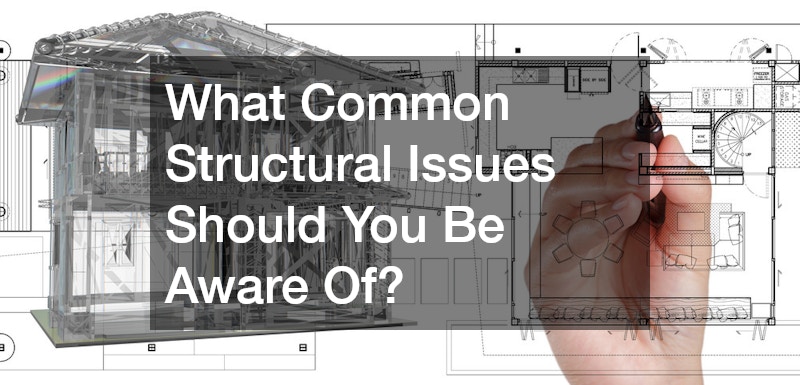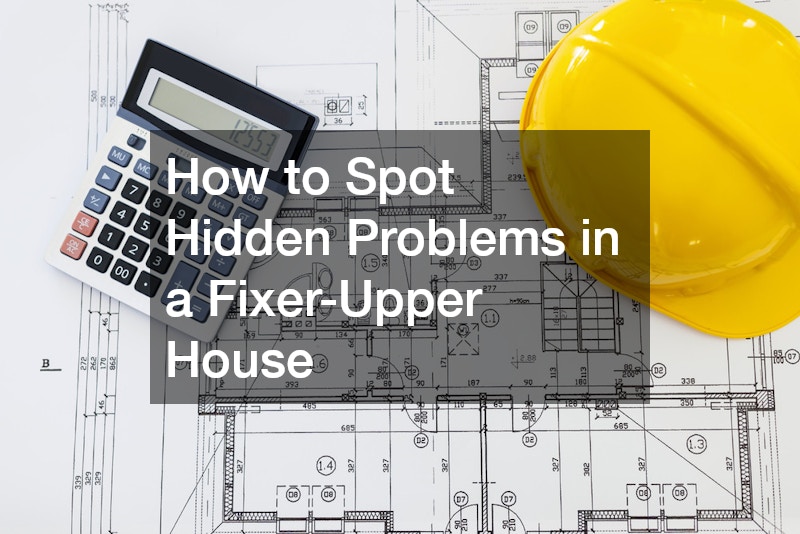Purchasing a fixer-upper home can be an exciting opportunity, offering the potential to customize a property, build equity, and create a dream space on a budget. However, these homes often come with hidden issues that may not be obvious during a quick walk-through or even a standard showing. Identifying underlying problems is essential to avoid costly repairs later, protect your investment, and ensure the home will be safe and structurally sound once renovations begin. Many buyers fall in love with the potential of a fixer-upper without fully understanding the risks that come with older or neglected properties.
Before committing to a purchase, it’s crucial to conduct a thorough inspection and learn how to recognize signs of deeper problems. From structural deficiencies and outdated electrical systems to hidden mold and heating failures, the issues you uncover can significantly influence renovation costs, timelines, and feasibility. Some problems are minor and easy to fix, while others may indicate unsafe conditions or require complete system replacements. Overlooking these issues can create financial strain or delay your move-in plans.
This guide provides a detailed look at how to spot hidden problems in a fixer-upper house. By understanding what to look for, knowing which specialists to consult, and preparing for potential red flags, you can make a smarter and more confident buying decision. Whether you’re an experienced property investor or a first-time homebuyer, recognizing these issues early helps ensure your renovation journey is safe, informed, and financially manageable.
What Common Structural Issues Should You Be Aware Of?

Structural issues are among the most expensive and dangerous problems in any fixer-upper. These include foundation cracks, sagging floors, bowing walls, roof weakness, and failing support beams. When a home’s structure begins to fail, every other component becomes vulnerable. Even cosmetic upgrades like installing new kitchen cabinets become risky if the surrounding walls or floors are unstable.
One of the first signs of a structural issue is visible cracking. Hairline cracks are common in older homes, but wide or stair-step cracks often indicate foundation movement. Uneven floors, doors that won’t close properly, or windows sticking can also signal shifting. If you notice sloping or soft spots in the floor, it may indicate rot, termite damage, or weakened joists.
Basements and crawl spaces deserve careful attention. Water intrusion, standing moisture, or crumbling concrete blocks point to serious foundation concerns. Likewise, beams that appear bowed, split, or over-notched reveal structural stress. While surface-level repairs may disguise these problems temporarily, the underlying issue will continue to worsen until properly addressed.
Hiring a structural engineer is often the best approach to assessing the extent of the damage. They can analyze the home’s stability, provide repair recommendations, and estimate potential costs. Spotting these issues early helps prevent escalating damage and ensures your renovation remains safe and successful.
Which Plumbing Problems Are Often Hidden?
Plumbing issues can be difficult to detect because most pipes sit behind walls, beneath floors, or inside ceilings. Hidden leaks, outdated piping, and poor drainage systems can become serious problems in a fixer-upper. Stains on ceilings or walls, musty smells, or soft flooring may indicate unseen water damage.
Many older homes were built using galvanized steel or polybutylene pipes, both of which deteriorate over time. These materials can cause rust, leaks, and low water pressure. Slowly dripping pipes may not be immediately noticeable, but over time they can rot subflooring, ruin drywall, and create mold problems.
Fixtures should also be inspected. Slow drains, gurgling toilets, or water backing up into sinks often signal clogged sewer lines or venting issues. A camera inspection is one of the best ways to evaluate the condition of underground pipes and sewer connections.
During home remodeling, plumbing repairs tend to be among the most disruptive because they may require opening walls or replacing entire pipe systems. Identifying issues early can save thousands of dollars and prevent major renovation delays.
How Can Electrical Issues Be Identified?
Electrical problems are common in fixer-upper homes, particularly in older properties built before modern wiring standards. Outdated wiring not only limits functionality but also presents a serious fire hazard. Flickering lights, warm outlets, frequently tripped breakers, and buzzing sounds may indicate wiring issues.
Knob-and-tube wiring, aluminum wiring, and overloaded circuit panels are all red flags. Many older systems were not designed to support today’s appliances, electronics, and HVAC systems. Extension cords or makeshift wiring solutions throughout the home signal that the electrical system may be dangerously inadequate.
A licensed inspector or a reputable home construction company can evaluate the existing electrical system and determine whether it meets current safety codes. Upgrading wiring may require opening walls, replacing the service panel, or adding new circuits. Because electrical repairs can be costly, identifying these problems before closing on a fixer-upper ensures the home is safe and helps you plan a realistic renovation budget.
What Are Signs of Poor Insulation?

Poor insulation leads to high energy bills, uncomfortable indoor temperatures, and excessive wear on heating and cooling systems. Many fixer-upper homes either lack insulation entirely or contain old materials that have deteriorated over time.
To identify insulation issues, check attic spaces first. Insulation should be evenly distributed and dry. Gaps, compressed areas, or visible ceiling joists indicate insufficient coverage. If the home feels drafty, especially near windows, doors, or outlets, insulation is likely lacking in the walls.
Old homes may use materials like newspaper, wood shavings, or outdated fiberglass, which provide minimal protection. Moisture stains or signs of rodents in attic or crawl space insulation suggest deeper issues.
Professionals such as local plumbers often notice insulation problems during service calls because poorly insulated pipes lead to freezing, sweating, or premature corrosion. Proper insulation is essential not only for comfort but also for the long-term health of the home’s systems.
How to Detect Mold and Mildew?
Mold and mildew thrive in damp, poorly ventilated environments—conditions common in neglected or older homes. Mold hidden behind walls or under floors can pose health risks and be expensive to remediate.
Musty odors are one of the first indicators, even if mold isn’t visible. Look for discoloration around sinks, showers, windows, and basements. Soft drywall, bubbling paint, or warped flooring often suggests moisture buildup.
Poor ventilation in bathrooms and kitchens can amplify mold growth, especially if exhaust fans are missing or nonfunctional. Basements with high humidity or past flooding are also prime areas for hidden mold.
Calling for an HVAC Service inspection is beneficial because improper airflow and old ductwork can contribute to mold growth. HVAC professionals can evaluate humidity levels and identify moisture trapped within ducts or vents.
If mold is suspected, a certified remediation specialist should test the air quality and determine the extent of contamination. Addressing mold promptly prevents further damage and protects indoor air quality.
What Are the Indications of Pest Infestation?
Pests such as termites, rodents, ants, and carpenter bees can cause extensive damage if left undetected. Fixer-upper homes—especially vacant ones—are particularly vulnerable to infestation.
Common signs include droppings, gnaw marks, chewed wires, hollow-sounding wood, and small piles of sawdust. Termites leave mud tubes along foundation walls, while carpenter ants may create rustling noises within walls. Rodents often nest in attics, basements, and behind appliances.
Holes or gaps near plumbing penetrations or damaged shingles can act as entry points. Replacing older entry doors can also help eliminate access since deteriorating wood frames often become nesting grounds for insects.
If pests are present, a pest control professional should assess the home before renovations begin. Infestations not only threaten structural stability but also introduce health hazards. Identifying pests early prevents long-term damage and helps ensure a safe renovation environment.
How Can You Identify Flooring Problems?

Flooring problems are common in fixer-uppers, especially in homes with moisture issues, foundation settling, or prolonged neglect. Soft spots, uneven surfaces, sagging floors, and gaps between floorboards often signal underlying damage.
Water damage is a major culprit. Warped hardwood, peeling vinyl, or moldy carpeting typically indicates leaks or improper moisture control. In older homes, subflooring may be compromised due to rot or termites. Tile floors may crack if installed on unstable surfaces, revealing deeper structural issues.
A careful walkthrough is essential. Listen for squeaks, which may suggest loose boards or failing joists. Bounce or sagging underfoot may reveal that the subfloor needs reinforcement.
A demolition company can help expose hidden floor damage during renovation, but identifying issues early is key to budgeting repairs accurately. Flooring problems often connect to plumbing, structural, or moisture issues, making early detection invaluable.
What Exterior Elements Should Be Inspected?
The exterior of a fixer-upper provides critical clues about the home’s overall condition. Damaged siding, peeling paint, cracked stucco, and rotten wood can indicate years of weather exposure or poor maintenance.
Start by examining the roof. Missing shingles, sagging sections, or damaged flashing suggest the roof may be at the end of its lifespan. Gutters should be clean and firmly attached. Overflowing or sagging gutters cause water to run down siding and into the foundation.
Inspect windows for cracked panes, failing seals, or rotting frames. Doors should open and close smoothly without scraping the frame. Exterior paint protects the home from moisture—peeling paint often precedes wood decay.
Professionals in house painting services can identify problematic surfaces, moisture intrusion, or conditions that would prevent paint from adhering properly. A thorough exterior inspection helps prevent costly surprises during renovation.
How to Evaluate Heating and Cooling Systems?
Heating and cooling systems are critical for comfort and safety. In fixer-upper homes, these systems are often outdated, neglected, or improperly maintained. Start by checking the age of the furnace and air conditioner—units older than 15 years may be inefficient or near failure. Older systems not only consume more energy but may also struggle to maintain consistent temperatures throughout the home, making them costly to operate.
Listen for unusual noises such as rattling, banging, or grinding, which may indicate mechanical issues. These sounds often suggest worn-out belts, loose components, or failing motors. Weak airflow, inconsistent temperatures, or foul smells point to problems within the system or ductwork. In many fixer-upper properties, ductwork has gone decades without cleaning or sealing, leading to energy loss, dust buildup, and uneven heating and cooling. Dirty filters, rusted components, or visible leaks require immediate attention, as they may contribute to poor air quality and system failure.
A professional electrician service can evaluate wiring and electrical load, ensuring the HVAC system operates safely and efficiently. Many older homes were not designed to support modern electrical demands, making an inspection essential before upgrading equipment. Proper evaluation helps determine whether repairs are feasible or if full replacement is necessary. Taking the time to assess the heating and cooling systems thoroughly prevents costly surprises, improves energy efficiency, and ensures the home remains safe and comfortable year-round.
What Hidden Costs Might Arise During Renovation?

Renovating a fixer-upper inevitably brings unexpected expenses. Even with a detailed inspection, some issues remain hidden until walls are opened or flooring is removed. Common hidden costs include asbestos removal, outdated plumbing or electrical systems, water damage, structural reinforcement, and mold remediation.
Many older homes contain hazardous materials like lead paint or asbestos, which require specialized removal. Water damage behind walls may not appear until demolition begins. Electrical upgrades can add thousands to your budget if panels or wiring are outdated.
Permits, inspections, and engineering reports also contribute to hidden costs. Foundation repair, window replacement, and roof reinforcement are some of the most expensive upgrades homeowners encounter unexpectedly.
Professionals specializing in roofing services often uncover attic ventilation issues, rotted beams, or structural concerns that require immediate attention. Building a financial buffer—typically 15–20% of your renovation budget—can help you manage surprises confidently.
Identifying hidden problems in a fixer-upper house is essential to protecting your investment, ensuring safety, and planning a realistic renovation. From structural issues and plumbing concerns to pests, mold, and outdated electrical systems, understanding what to look for helps prevent costly surprises later. A thorough inspection allows you to make informed decisions, negotiate confidently, and prioritize repairs based on urgency and budget.
Whether you’re a seasoned renovator or a first-time buyer, approaching a fixer-upper with knowledge and preparation will significantly improve your experience. By recognizing common red flags and seeking professional guidance when needed, you can transform even the most neglected property into a safe, comfortable, and valuable home.
